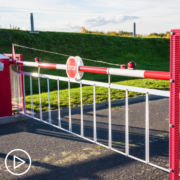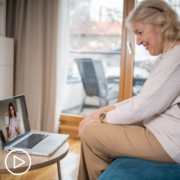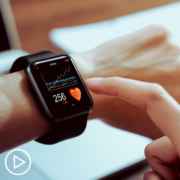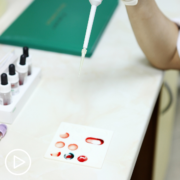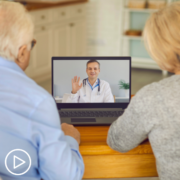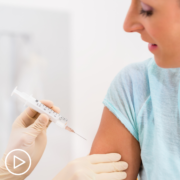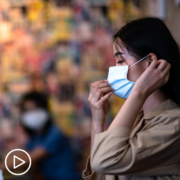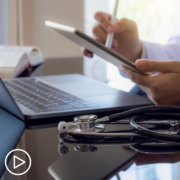How Can CLL Patients Avoid Pandemic Challenges Without Compromising Quality of Care? from Patient Empowerment Network on Vimeo.
How can chronic lymphocytic leukemia (CLL) patients ensure that they receive quality care even during high-risk times like pandemics? Dr. Kathy Kim from UC Davis School of Medicine shares her recommendations for providers and information about remote monitoring devices for improved patient care.
See More from Best CLL Care No Matter Where You Live
Related Resources:
Transcript:
Dr. Awan:
You know, with so many patients nowadays who are worried about their cancer care and how that will continue, and especially now with remote monitoring. How, what kind of tools do you have deployed and used, what would be your recommendations for us and how we can make us some of these new innovations and new methods to provide the best care for our patients?
Dr. Kim:
I think even when you’re thinking about using technology, again, it’s not one-size-fits all, it is what the provider is comfortable with and what the patient is comfortable with, and what you two can work together to improve your care. So, I think there are a lot of innovations that have been developed over many years, but this past year under COVID, we saw an acceleration of people adopting them because it was out of necessity that people didn’t come in to a setting where they might potentially be infected or to infect others. So, we certainly saw a huge increase in telehealth, which has been virtual visits, like we’re doing right now, we are virtually visiting with each other or telephone visits, so there’s been a huge upsurge in the number of hospitals and clinics and practices that have been able to implement telehealth with their patients. But there are other tools that again, have been in development that are now starting to take off under the last year, and those are remote patient monitoring devices, these are either specific medical devices, like blood pressure machines, glucose meters, some heart monitors, sleep monitors, you know things that, devices that check your oxygen saturation. So, there are many medical devices that are for use in the home, that are either covered by insurance or people can buy them at the drug store, and what has really come about this year is the ability to connect the data from the device you have in your home to your provider, so that’s been in place, but we really haven’t implemented it very many places, and now lots of places are allowing that connection to happen. So, the patient can use the device in their home and get it connected to the and have it sent to the hospital or to their doctor, so their doctor can be watching the data and also monitoring them, so that’s one really wonderful piece of progress that we’ve had in the past year. I would say the third area that again, has been around for a while but people haven’t used it so much has been mobile applications.
So, these are basically software that you can run on your smartphone or you can run it on a tablet or a computer that let you track your own information. So, I know CLL patients and many cancer patients have lots of documents from all the treatments, from all the visits that they have had, and it’s a challenge to manage all those medical records because you might go to multiple places, right? You’re not always going to the same place. So, now there are many applications that are integrated with the record systems that your hospital or doctor has, where you can aggregate all of your records in one place, and that way when you go to talk to another provider or have this second opinion or a consult, you have access to all your records that you can share. And then you can also track things that are important to you, so maybe you want to track how I feel, what my symptoms are under certain kinds of medications or when I do more physical activity, do I get more tired or do I actually feel better, you know track and by taking my other medications, and for many of us, just remembering to take your medications every day is hard enough if you have several medications and they’re at different times, you might not remember, did I take that one already or do I still need to take it? And so, these applications can also set up your medication schedule and help you to track whether you’ve taken them or not, so there are lots of these tools now available where you can start to manage all of these things and share that information with your doctor.
You know, with so many patients nowadays who are worried about their cancer care and how that will continue, and especially now with remote monitoring. How, what kind of tools do you have deployed and used, what would be your recommendations for us and how we can make us some of these new innovations and new methods to provide the best care for our patients?
I think even when you’re thinking about using technology, again, it’s not one-size-fits all, it is what the provider is comfortable with and what the patient is comfortable with, and what you two can work together to improve your care. So, I think there are a lot of innovations that have been developed over many years, but this past year under COVID, we saw an acceleration of people adopting them because it was out of necessity that people didn’t come in to a setting where they might potentially be infected or to infect others. So, we certainly saw a huge increase in telehealth, which has been virtual visits, like we’re doing right now, we are virtually visiting with each other or telephone visits, so there’s been a huge upsurge in the number of hospitals and clinics and practices that have been able to implement telehealth with their patients. But there are other tools that again, have been in development that are now starting to take off under the last year, and those are remote patient monitoring devices, these are either specific medical devices, like blood pressure machines, glucose meters, some heart monitors, sleep monitors, you know things that, devices that check your oxygen saturation. So, there are many medical devices that are for use in the home, that are either covered by insurance or people can buy them at the drug store, and what has really come about this year is the ability to connect the data from the device you have in your home to your provider, so that’s been in place, but we really haven’t implemented it very many places, and now lots of places are allowing that connection to happen. So, the patient can use the device in their home and get it connected to the and have it sent to the hospital or to their doctor, so their doctor can be watching the data and also monitoring them, so that’s one really wonderful piece of progress that we’ve had in the past year. I would say the third area that again, has been around for a while but people haven’t used it so much has been mobile applications.
So, these are basically software that you can run on your smartphone or you can run it on a tablet or a computer that let you track your own information. So, I know CLL patients and many cancer patients have lots of documents from all the treatments, from all the visits that they have had, and it’s a challenge to manage all those medical records because you might go to multiple places, right? You’re not always going to the same place. So, now there are many applications that are integrated with the record systems that your hospital or doctor has, where you can aggregate all of your records in one place, and that way when you go to talk to another provider or have this second opinion or a consult, you have access to all your records that you can share. And then you can also track things that are important to you, so maybe you want to track how I feel, what my symptoms are under certain kinds of medications or when I do more physical activity, do I get more tired or do I actually feel better, you know track and by taking my other medications, and for many of us, just remembering to take your medications every day is hard enough if you have several medications and they’re at different times, you might not remember, did I take that one already or do I still need to take it? And so, these applications can also set up your medication schedule and help you to track whether you’ve taken them or not, so there are lots of these tools now available where you can start to manage all of these things and share that information with your doctor.
